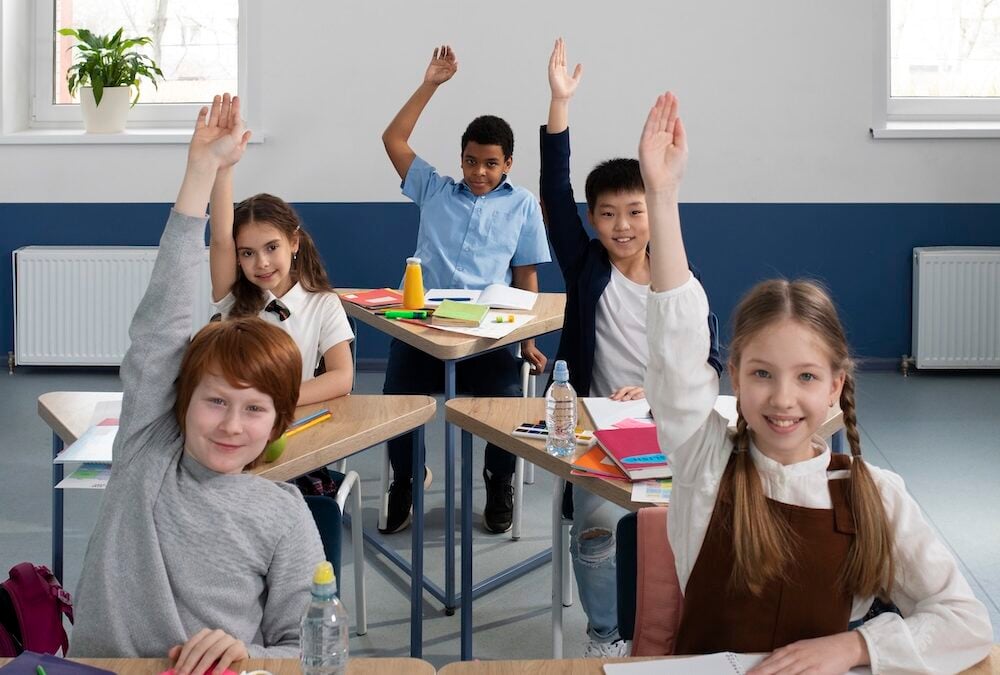
Walk into any classroom, and you can feel the difference. Some rooms hum with trust, laughter, and learning. Others feel tense, disconnected, or uncertain. That feeling? It’s classroom culture—and it matters.
At its heart, building culture in a classroom creates safety. A space where every child feels seen, respected, and part of something bigger than themselves. It’s not built overnight. But with intention, community agreements, and meaningful connection, it becomes the foundation for everything else: learning, risk-taking, creativity, and kindness.
Let’s explore how we can create a peaceful and welcoming classroom, grounded in social emotional learning and respect for all.
What Is Classroom Culture, Really?
Our definition of classroom culture:
The shared values, norms, and behaviors that shape how people interact, feel, and grow together in a learning environment.
It’s the invisible thread that ties together your classroom management, student relationships, and the overall classroom climate. When it’s rooted in empathy, consistency, and student voice, it helps children feel emotionally safe—ready to learn, share, and thrive.
Why Classroom Culture Is Foundational to Learning
Before academic growth comes emotional safety. A strong classroom culture supports:
✔ Emotional regulation and respectful communication
✔ A sense of belonging and inclusion
✔ Student agency and ownership of learning
✔ Resilience when conflict or mistakes arise
When students trust their environment, they’re more willing to take risks, speak up, and support one another. That’s how we begin creating a positive classroom climate—through consistent care and community.
Core Elements of a Positive Classroom Culture
Let’s break it down into what you can see, feel, and co-create with your students.
1. Community Agreements Built Together
Rather than posting classroom rules, invite students to co-create shared values:
- What helps us feel safe and included?
- How do we want to treat each other when things feel hard?
- What helps us solve problems together?
This classroom values list can become an anchor point for class check-ins, conflict resolution, and reflection. It’s not just a poster—it’s a living document shaped by the group.
Related tool: Explore how Soul Shoppe’s Tools of the Heart helps students develop the language and skills to communicate needs and repair conflict with compassion.
2. Respect and Empathy as Daily Practice
Respect isn’t a one-time lesson. It’s embedded in the tone of voice we use, the way we handle disagreements, and the opportunities we create for students to be heard.
Ways to practice:
- Daily check-ins to acknowledge how students are feeling
- Peer interviews to learn what classmates enjoy or struggle with
- Celebrating diverse perspectives and lived experiences
Inclusive classroom culture grows from everyday kindness and understanding—not just big, structured lessons.
3. Consistent Routines with Flexibility and Heart
Predictability gives students emotional safety. At the same time, flexibility shows students that their needs matter. Finding that balance is what shapes a supportive classroom climate.
Tips:
- Use visuals or rhythms to signal transitions
- Allow students to pause, breathe, or ask for breaks when overwhelmed
- Be clear about expectations, but compassionate with mistakes
Need inspiration? Soul Shoppe’s Elementary SEL curriculum offers adaptable routines for every classroom.
4. Trust-Building Activities That Help Student Voices Be Heard
Trust isn’t automatic—it’s built. And in the classroom, it grows through play, storytelling, and real listening.
Try these trust-building classroom activities:
- “I Wish My Teacher Knew…” (anonymous or shared)
- Compliment circles or “kindness shoutouts”
- Partner storytelling about times students helped someone else
These simple moments build bridges—and remind students they matter.
Classroom Culture Activities That Make an Impact
Here are a few easy-to-integrate classroom culture activities to spark connection and create space for reflection:
Culture Walk
Invite students to walk around the room and stop at stations with prompts like:
- “I feel most included when…”
- “One thing I wish grownups knew…”
- “Here’s what makes me feel brave…”
This fosters vulnerability and class empathy.
Games and Activities That Teach Emotional Awareness
Try Soul Shoppe’s quality tools for education, including SEL games that explore topics like:
- Active listening
- Emotional regulation
- Conflict resolution
- Team collaboration
See how these integrate into your positive classroom culture activities by connecting to our Planet Responsibility curriculum—an initiative designed to help students take ownership of their impact and role in the classroom community.
Bringing Social Emotional Learning into School Culture
It’s not just about the classroom—it’s about the entire school culture. When every adult models emotional intelligence, accountability, and compassion, we create ripple effects that reach every student.
Soul Shoppe’s programs are designed to support that journey—with curriculum like Tools of the Heart and school-wide practices that make SEL tangible, joyful, and meaningful.
Creating a Safe, Joyful Place to Learn
Strong classroom culture doesn’t require perfection. It simply asks for consistency, curiosity, and care. When we invite students to co-create the classroom experience, we give them ownership. When we model empathy and repair, we teach emotional strength.
And when we build together, every student gets to show up as their full self.
That’s the power of a peaceful, welcoming classroom.
You May Also Like:
How To Teach Kids To Include Others Even When It’s Hard
Teaching Perseverance to Kids
Self-Regulation Activities for Kids
How SEL Supports Neurodiverse Students

Conflict is a natural part of growing up. Whether it’s a disagreement over sharing supplies, a miscommunication on the playground, or a clash of opinions in group work, students are constantly navigating relationships. But with the right tools and guidance, these moments can become powerful learning opportunities.
This is where educators and school staff play a vital role. Instead of stepping in to fix every disagreement, we can give students the tools to solve conflicts independently—building their confidence, empathy, and problem-solving skills.
In this article, we’ll explore practical, age-appropriate conflict resolution strategies for students, how adults can support without taking over, and how programs like Soul Shoppe’s Peacemaker Training, Tools of the Heart, and Planet Responsibility equip students to build peaceful, connected communities.
Why Conflict Resolution Belongs in the Classroom
When students learn to manage conflict early on, they’re not just solving problems—they’re developing lifelong skills:
✔ Listening with empathy
✔ Communicating clearly and kindly
✔ Taking responsibility for their actions
✔ Finding creative, respectful solutions
By nurturing conflict resolution in educational settings, we create classrooms that are not only calmer but also more connected.
Conflict Resolution Strategies for Elementary Students
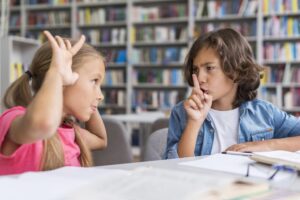 Let’s walk through student-centered strategies that give kids the tools to navigate tough moments themselves, with adult support when needed.
Let’s walk through student-centered strategies that give kids the tools to navigate tough moments themselves, with adult support when needed.
1. Use a Step-by-Step Process
Teach students a simple, repeatable method for working through problems. Soul Shoppe’s “I Message” framework or Peace Path tools are great examples:
- Stop and breathe
- Say how you feel
- Say what happened (without blame)
- Listen to the other person
- Work together on a solution
This process is at the heart of our Peacemaker Training—a program that helps students take on leadership roles in resolving peer conflicts, with guidance from trusted adults.
2. Practice with Conflict Resolution Scenarios for Students
Role-playing is a powerful way to prepare students for real-life challenges. Try these conflict resolution scenarios for students:
- “Your partner didn’t do their part in a group project—what do you do?”
- “Two friends both want the same ball during recess—how can they solve it together?”
- “Someone made a joke that hurt your feelings—how can you tell them in a kind way?”
Walk through these with the class or in small groups, using role-play and reflection to build empathy.
3. Empower Students with a Mediation Role
Student conflict resolution becomes even more effective when students lead it. That’s why we train Peacemakers—students who learn how to teach mediation, guide peers through conflict, and model respectful behavior.
With guidance, students can even complete a student mediation agreement outlining what happened, what each person needs, and what steps they’ll take moving forward.
How Adults Can Support Without Taking Over
When students are in conflict, adults may feel the urge to step in and fix the problem. But with support and guidance, students can often work it out themselves. Here’s how to help:
Coach, Don’t Control
Instead of directing the conversation, ask questions that guide students toward solutions:
- “What do you think happened?”
- “How do you think they felt?”
- “What would be a fair way to move forward?”
Stay Neutral and Present
Avoid taking sides or assigning blame. Be a calm, supportive presence that reassures students they are safe and capable of working through the issue.
Model Reflective Listening
Demonstrate how to truly listen by reflecting what a student says:
- “So you’re feeling frustrated because…”
- “You wanted to play, but they didn’t hear you?”
Modeling these skills teaches students how to do the same for each other.
Integrating Conflict Resolution into Daily Classroom Life
Teaching classroom conflict resolution isn’t a one-time lesson—it’s a culture. Build it into your daily rhythm with these ideas:
Start the Day with a Check-In
Use feelings charts or morning circles to help students share what they’re carrying into the day.
Create a Classroom Agreement Together
Let students co-create the classroom norms. This builds ownership and a shared commitment to kindness and responsibility.
Play Conflict Resolution Games
Games help students build skills in a fun and low-pressure way. Try some conflict resolution games for kids—designed to encourage empathy, problem-solving, and collaboration.
Tools and Programs that Support Student-Led Conflict Resolution
Soul Shoppe offers structured programs that help embed conflict resolution strategies for students in a sustainable and meaningful way:
Peacemaker Training
Peacemaker Training is a whole-school model for how to resolve conflict in school—empowering students as peer mediators and providing staff with tools to guide peaceful resolution.
Tools of the Heart
Tools of the Heart is a social-emotional learning curriculum that teaches emotional awareness, communication skills, and self-regulation—all foundational for conflict management in schools.
Planet Responsibility
Planet Responsibility gives students a framework for understanding how their actions affect others and how they can take ownership and make things right. It’s about turning mistakes into meaningful growth.
Let Students Lead with Our Support
Conflict isn’t something to avoid—it’s something to grow through. With the right structures in place, strategies to resolve conflict, and trusted adults modeling compassion and respect, students become confident in their ability to navigate challenges.
By teaching conflict resolution strategies for students, we’re not just creating more peaceful classrooms—we’re shaping compassionate, courageous leaders.
Let’s give them the tools—and the trust—to lead the way. To learn more, contact us!
You May Also Like:
Classroom Culture: How To Build A Peaceful And Welcoming Space
Teaching Assertiveness vs. Aggressiveness
Boundaries Activities for Kids
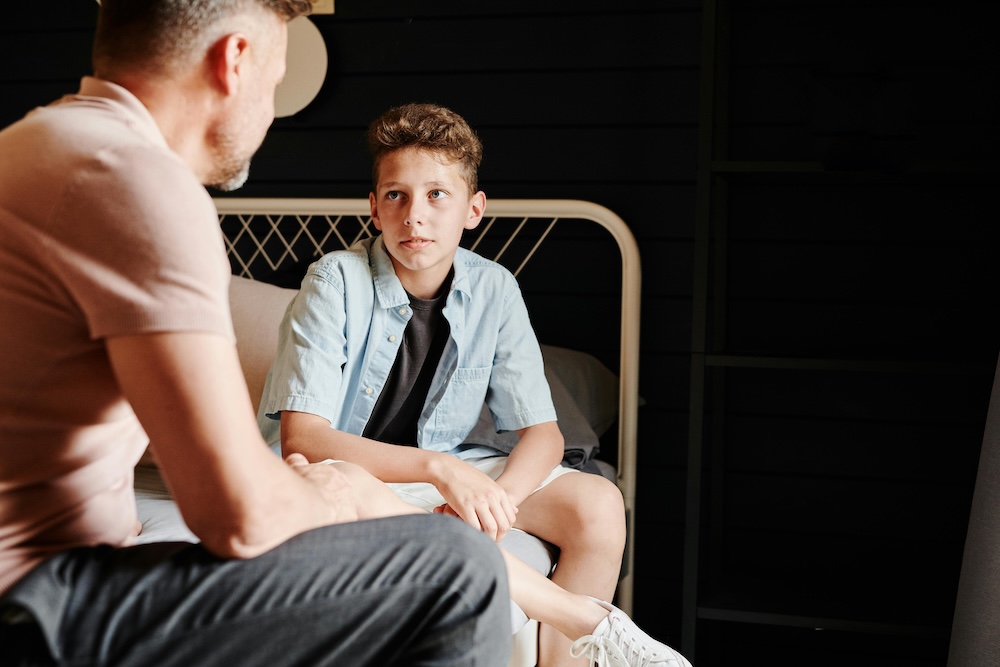
The world can sometimes feel overwhelming—not just for adults, but especially for children. Whether it’s a natural disaster on the news, a loss in the family, or big changes at home, kids rely on the adults around them to help make sense of life’s hardest moments.
Talking about these experiences isn’t always easy, but when we hold space for honest, age-appropriate conversations, we give children a chance to feel heard, grounded, and supported.
At Soul Shoppe, we believe every moment is an opportunity for connection. This includes the tough ones. In this article, we’ll share gentle, SEL-informed guidance for how to talk to your child about difficult topics, from natural disasters to grief and beyond.
Why These Conversations Matter
When children face uncertainty or distress and don’t have the language or support to process it, their emotions can build up and show up in unexpected ways, like outbursts, anxiety, or withdrawal.
They may not ask directly, but they are listening. They’re watching how we react and what we say (or don’t say). By being present and honest in a developmentally appropriate way, we model emotional resilience and invite children into safe, supportive conversations.
A Gentle List of Tough Topics to Talk About
Below are some hard topics to talk about that children may experience or hear about in school, at home, or through the media.
- Natural disasters (e.g., earthquakes, wildfires, hurricanes)
- Violence in the news or community
- Death of a pet, loved one, or public figure
- Divorce or separation
- Illness or medical emergencies
- Big changes like moving or changing schools
- Environmental issues (e.g., climate change)
- Global conflict or war
Each of these can prompt big feelings, confusion, and questions, especially when they’re unexpected.
How to Talk to a Child About Difficult Topics
 Let’s walk through a few ways to open up these conversations with care and connection.
Let’s walk through a few ways to open up these conversations with care and connection.
1. Start with a Check-In
Before diving into any tough topic, create space to see how your child is already feeling. You might say:
- “Have you heard anything about what happened today?”
- “How are you feeling about everything?”
- “I noticed you’ve been quiet lately—want to talk?”
Children may not always have the words, but asking opens the door for connection.
2. Keep Language Clear, Honest, and Age-Appropriate
You don’t have to explain everything, but children do need clarity. Speak truthfully, using simple language that matches their developmental stage.
Example:
- For a natural disaster: “There was a big storm in the city next to us. People are helping to keep everyone safe.”
- For death: “That means their body stopped working, and they won’t come back. It’s okay to feel sad.”
Avoid overcomplicating or minimizing. Honesty, even in small doses, builds trust.
3. Reassure, Without Overpromising
Children want to know: Am I safe? Are the people I love safe?
- Offer comfort with facts: “We’re safe right now.”
- Remind them of the helpers: “There are so many people working to help others.”
And let them know it’s okay to have big feelings: “It’s normal to feel scared or sad about this.”
4. Let Emotions Have Space
Tears, silence, anger—these are all natural responses to stress or grief. Rather than rushing to “fix” the feeling, be a calm presence beside it.
- “It’s okay to cry. I’m here with you.”
- “You don’t have to talk right now. Just know I’m here when you’re ready.”
When navigating children and grief, know that it doesn’t follow a straight line. Some days will be heavy, others lighter. Keep the door open for ongoing conversations.
Examples of Difficult Topics in Real Life—and How to Talk Through Them
Here are a few real-world scenarios with sample language you can adapt:
A Natural Disaster on the News
“Something big happened, and lots of people are working hard to help. It might feel scary, but we’re safe here. Would you like to talk more about it or ask questions?”
When a Pet or Family Member Dies
“[Name] died, and that means we won’t see them again. It’s okay to feel sad or miss them. I miss them too. Want to remember a favorite story together?”
Divorce or Separation
“Things are changing, but what stays the same is how much we both love you. You’re not alone in this—we’ll go through it together.”
These conversations are hard, but they’re also deeply healing.
How Social Emotional Learning Supports Tough Conversations
SEL gives children the tools to name their emotions, regulate their bodies, and connect with empathy—skills that are essential during times of stress or change.
At Soul Shoppe, our social emotional learning programs, like Tools of the Heart, offer age-appropriate activities that help children build inner resilience.
Whether it’s learning to breathe through strong emotions, practicing kindness, or navigating peer conflict, SEL makes space for the kind of emotional growth that supports kids during life’s hardest moments.
Helpful Tips for Grown-Ups Navigating These Topics
Be okay with not having all the answers. Saying, “I don’t know, but we can find out together,” is powerful.
Limit overexposure to media. Curate age-appropriate news and take breaks when needed.
Use art, storytelling, or play to help kids express themselves.
Model emotional regulation. Let them see you take deep breaths, pause, or ask for help.
Check in later. Conversations around childhood stress or grief are ongoing—don’t make it a one-time event.
You Don’t Have to Do It Alone
If a child is dealing with grief, fear, or ongoing distress, it’s okay to seek support.
- Speak with school counselors
- Share grief resources for students
- Reach out to community programs and educators trained in SEL
Even small steps—like a breathing exercise or a reassuring word—can mean everything to a child.
Be the Safe Place
Learning how to talk to your child about difficult topics isn’t about having all the answers—it’s about being the steady, supportive presence children can trust.
By meeting kids with honesty, empathy, and calmness, you show them that even when the world feels big or uncertain, they are not alone.
And in that safe space, healing can begin.
You May Also Like:
Teaching Perseverance to Kids

Anxiety is one of the most common challenges students face, affecting their ability to focus, participate, and thrive in the classroom. Whether it’s test anxiety, social worries, or academic pressures, understanding how to help students with anxiety is essential for educators. By providing the right support, teachers can create a classroom environment that helps students feel safe, empowered, and capable of managing their stress.
This article explores the causes of anxiety in students, the impact of anxiety in the classroom, and practical interventions for students with anxiety that teachers can implement to support their emotional well-being.
Understanding Anxiety in Students
Anxiety in students can manifest in many ways, from physical symptoms like stomachaches to avoidance behaviors such as refusing to participate in class discussions. While occasional nervousness is a natural part of growing up, persistent anxiety can interfere with a child’s ability to learn and engage with their peers.
How Anxiety Affects School Performance
Students with anxiety may struggle with:
✔ Concentration and Memory: Stress can make it difficult to focus on lessons and retain information.
✔ Participation and Engagement: Fear of making mistakes or speaking up in class can lead to avoidance.
✔ Social Interactions: Anxiety can make forming friendships or working in groups overwhelming.
✔ Test Performance: Performance anxiety can cause students to freeze or struggle to demonstrate their knowledge under pressure.
Recognizing these challenges allows teachers to provide helpful resources for students with anxiety and create a supportive learning environment.
Common Causes of Anxiety in Students
Understanding the causes of anxiety in students helps educators anticipate triggers and provide meaningful support. Some of the most common causes include:
- Academic Pressure: High expectations and fear of failure can make students anxious about tests, homework, and class participation.
- Social Anxiety: Worries about fitting in, making friends, or speaking in front of others can be overwhelming.
- Change or Uncertainty: Transitions such as moving to a new school, changing teachers, or adjusting to new routines can cause stress.
- Sensory Overload: Noisy, busy environments can be difficult for students with sensory sensitivities.
- Perfectionism: Some students set extremely high standards for themselves, leading to frustration when they don’t meet their own expectations.
By identifying specific stressors, teachers can implement interventions for students with anxiety that address individual needs.
How Teachers Can Help Students with Anxiety
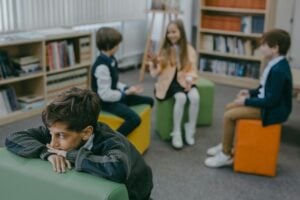
Educators play a critical role in supporting students with anxiety by fostering a calm, inclusive, and predictable environment. Below are key strategies to help anxious students feel more at ease.
1. Create a Safe and Supportive Classroom Environment
A welcoming classroom helps reduce anxiety in the classroom by making students feel secure and valued. Strategies include:
✔ Consistent Routines: Predictability can ease stress, so establish clear schedules and expectations.
✔ Flexible Seating Options: Let students choose quiet spaces when they need a break.
✔ Encouraging Words: Offer reassurance and positive reinforcement, even for small achievements.
2. Teach Mindfulness and Relaxation Techniques
Mindfulness helps students regulate emotions and manage stress. Simple techniques include:
✔ Deep Breathing Exercises: Teach students to take slow, deep breaths when they feel anxious.
✔ The Empty Balloon Exercise: The Empty Balloon guides students through mindful breathing, helping them calm down in moments of stress.
✔ Grounding Activities: Encourage students to focus on their senses (what they see, hear, and feel) to stay present in the moment.
3. Provide Emotional Support and Validation
Students with anxiety need to feel heard and understood. Teachers can:
✔ Check In Regularly: A quick “How are you feeling today?” can help students open up.
✔ Normalize Anxiety: Let students know that it’s okay to feel nervous and that they are not alone.
✔ Offer a Calm-Down Space: Create a designated area where students can take a break when needed.
4. Encourage Positive Self-Talk and Growth Mindset
Help students reframe anxious thoughts with encouraging messages:
🔹 Instead of: “I’ll never get this right.” → Say: “I’m still learning, and I’ll get better with practice.”
🔹 Instead of: “Everyone will laugh if I make a mistake.” → Say: “Everyone makes mistakes. That’s how we learn.”
5. Offer Flexible Participation Options
Some students may feel overwhelmed speaking in front of the class or participating in group activities. Support them by:
✔ Allowing written responses instead of verbal answers.
✔ Pairing them with a trusted friend for partner work.
✔ Giving them the option to present privately or in small groups.
6. Promote Social-Emotional Learning (SEL) Strategies
SEL helps students build confidence, emotional regulation, and resilience. The Tools of the Heart curriculum provides structured lessons that teach students how to recognize, process, and manage emotions effectively.
Interventions for Students with Anxiety

1. Sensory Breaks in the Classroom
Short sensory breaks can help students reset and manage their emotions. These include:
✔ Stretching or movement breaks to release built-up tension.
✔ Fidget tools for students who need to channel nervous energy.
✔ Listening to calming music during quiet work times.
2. Journaling and Expressive Writing
Encourage students to write about their feelings in a journal. Writing helps students:
✔ Process emotions in a safe and private way.
✔ Identify patterns in their anxiety triggers.
✔ Reflect on positive moments and growth.
3. Teaching Emotional Vocabulary
Many students struggle to articulate their emotions. Teach them phrases like:
✔ “I feel nervous because…”
✔ “I need help with…”
✔ “When I get anxious, it helps me to…”
The more students can express their emotions, the easier it is to find solutions.
4. Peer Support and Classroom Community
Encourage peer support by:
✔ Practicing kindness and empathy in classroom discussions.
✔ Using buddy systems to help students feel included.
✔ Reinforcing the idea that classmates should support, not judge, each other.
Resources for Students with Anxiety
Helping students with anxiety requires ongoing support and accessible resources. Teachers can integrate structured programs like:
- The Empty Balloon: A guided breathing tool that helps students self-regulate.
- Tools of the Heart: A social-emotional learning curriculum that builds confidence and emotional resilience.
- Classroom Relaxation Stations: Create a space with calming tools like stress balls, quiet reading materials, or soft lighting.
- Mindfulness Apps for Kids: Apps like Headspace for Kids or Calm can provide guided relaxation exercises.
By providing these resources for students with anxiety, teachers create a more inclusive and supportive classroom environment.
Supporting Students with Anxiety in the Classroom
Understanding how to help students with anxiety goes beyond academic support—it’s about creating a safe space where students feel heard, valued, and equipped to manage their emotions. By implementing interventions for students with anxiety, offering SEL resources, and building strong teacher-student relationships, educators can help students develop resilience and confidence.
Want to bring structured emotional learning to your classroom? Explore Tools of the Heart for evidence-based strategies to support students with anxiety in meaningful ways.
You May Also Like:
How To Talk To A Child About Difficult Topics
Embodiment Practices For Kids
Self-Esteem Group Activities
Classroom Culture
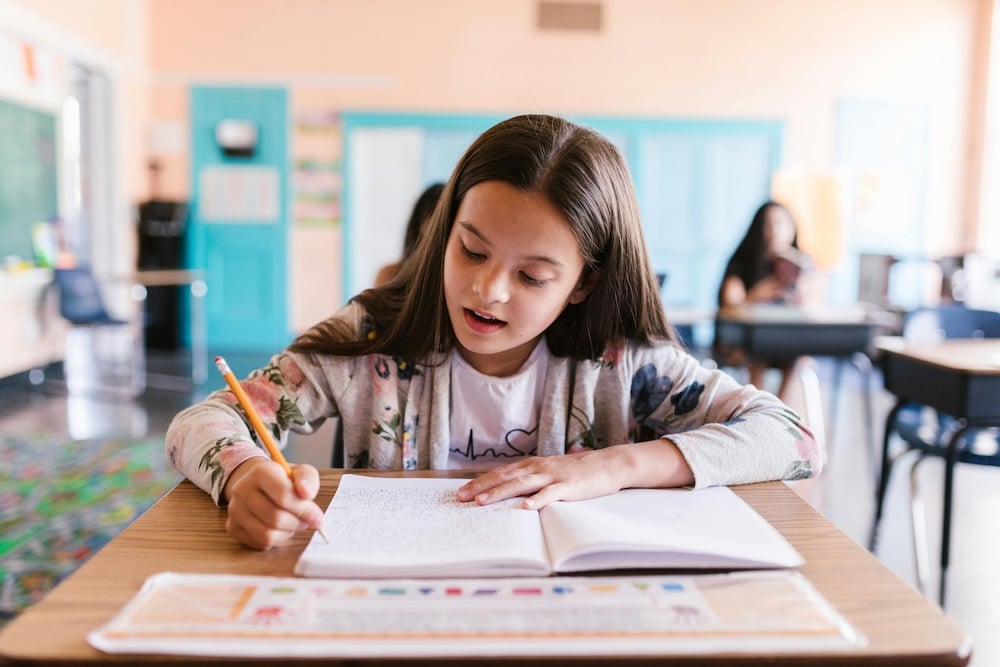
Developing a growth mindset in the classroom is essential for helping students embrace challenges, persist through difficulties, and see mistakes as learning opportunities. When students believe their abilities can improve with effort and practice, they develop resilience and motivation that extend beyond academics into all areas of life.
By integrating social-emotional learning (SEL) and teaching growth mindset, educators can empower students to develop the confidence and problem-solving skills they need to navigate obstacles with a positive outlook. In this article, we’ll explore growth mindset strategies for students, classroom growth mindset activities, and ways teachers can create a growth mindset for the classroom through structured SEL practices.
What Is a Growth Mindset?
A growth mindset for students is the belief that intelligence, abilities, and talents can develop through effort, persistence, and learning from mistakes. This contrasts with a fixed mindset, where students believe their intelligence and skills are unchangeable.
Growth Mindset Definition for Students
A simple way to explain growth mindset in schools to young learners is:
“When you practice and keep trying, your brain gets stronger, and you get better at things over time!”
Why Is Growth Mindset Important for Students?
Students with a growth mindset in education:
✔ Take on Challenges: They see obstacles as growth opportunities rather than roadblocks.
✔ Develop Resilience: They bounce back from misses and keep trying despite setbacks.
✔ Stay Motivated: They understand that effort leads to improvement.
✔ Enjoy Learning: They are more open to feedback and new learning experiences.
By fostering a growth mindset for students, teachers help them develop the perseverance they need for both academic and personal success.
The Connection Between Growth Mindset and SEL
 SEL (Social-Emotional Learning) plays a critical role in growth mindset in the classroom. SEL teaches students essential life skills, including emotional regulation, self-awareness, and perseverance—traits that directly support teaching growth mindset.
SEL (Social-Emotional Learning) plays a critical role in growth mindset in the classroom. SEL teaches students essential life skills, including emotional regulation, self-awareness, and perseverance—traits that directly support teaching growth mindset.
Through structured SEL programs like Tools of the Heart, students learn to:
- Recognize and manage emotions when facing challenges.
- Develop self-confidence in their ability to improve and grow.
- Practice empathy in learning environments by encouraging peers and embracing collaborative problem-solving.
By integrating SEL principles into growth mindset classroom activities, teachers create a supportive space where students feel safe to take risks, learn from mistakes, and push beyond their comfort zones.
Growth Mindset Strategies for Students
1. Encourage the Power of “Yet”
Students often say, “I can’t do this,” but adding “yet” transforms their mindset:
🔹 “I can’t do this… yet.”
🔹 “I don’t understand… yet.”
This small change shifts their thinking toward progress rather than limitation.
2. Reframe Mistakes as Learning Opportunities
Instead of leaning into fears of failure, students should see mistakes as part of the learning process. Teachers can:
✔ Share personal stories about overcoming challenges.
✔ Celebrate mistakes as evidence of effort and growth.
✔ Encourage reflection by asking students what they learned from their struggles.
3. Praise Effort, Not Just Results
Rather than saying, “You’re so smart!”, focus on effort-driven praise:
🔹 “I love how you kept trying, even when it was hard!”
🔹 “That was a great strategy—you’re improving because of your practice.”
This reinforces a growth mindset for the classroom by highlighting persistence over natural ability.
4. Use Growth Mindset Language
Help students develop a strong growth mindset in education by modeling positive self-talk:
- Instead of: “This is hard.” → Say: “This will take time and practice.”
- Instead of: “I made a mistake.” → Say: “Mistakes help me learn.”
- Instead of: “I’ll never get this.” → Say: “I can improve with effort.”
Language shapes mindset, and consistent reinforcement makes a lasting impact.
Growth Mindset Classroom Activities
1. The Growth Mindset Journal
Encourage students to keep a journal where they:
✔ Write about a challenge they faced and how they handled it.
✔ Reflect on what they learned from a mistake.
✔ Set personal learning goals and track their progress.
This simple activity builds self-awareness and perseverance.
2. Brainstorm “Famous People Who Succeeded With Challenges”
Show students growth mindset examples by discussing people who faced setbacks before succeeding. Examples include:
- Thomas Edison (tried and missed 1,000+ times before inventing the lightbulb).
- Michael Jordan (was cut from his high school basketball team).
- J.K. Rowling (her book was rejected by 12 publishers).
Discuss how these individuals embraced challenges, persisted, and ultimately achieved success.
3. The Growth Mindset Challenge Board
Create a classroom board with weekly challenges that encourage effort and persistence, such as:
✔ “Try something new and share what you learned.”
✔ “Work on a skill you struggle with for 10 minutes a day.”
✔ “Help a friend when they feel stuck.”
This activity promotes growth mindset strategies for students while reinforcing peer encouragement.
4. Fixed vs. Growth Mindset Sort
Provide students with statements and have them sort them into “Fixed Mindset” vs. “Growth Mindset” categories. Examples:
✔ “If I’m not good at something, I should stop trying.” (Fixed)
✔ “With practice, I can improve at anything.” (Growth)
This helps students recognize unhelpful thought patterns and shift toward a growth mindset in schools.
Creating a Growth Mindset Classroom Environment
Incorporating a growth mindset for the classroom goes beyond activities—it’s about creating a culture that values persistence, curiosity, and resilience.
Classroom Growth Mindset Tips
- Model Growth Mindset Behavior – Share your own learning experiences and struggles.
- Normalize Effort Over Perfection – Encourage students to try their best rather than fear failure.
- Celebrate Small Wins – Acknowledge incremental progress in learning.
- Encourage Peer Support – Teach students to uplift and encourage each other when facing challenges.
By consistently reinforcing these principles, teachers can create a classroom growth mindset that helps students develop lifelong learning habits.
Empower Your Students with a Growth Mindset
Developing a growth mindset in the classroom transforms the way students approach challenges and setbacks. By integrating growth mindset strategies for students alongside SEL principles, educators help students cultivate perseverance, resilience, and confidence in their ability to grow.
Looking for more structured SEL resources? Check out Soul Shoppe’s Tools of the Heart Online Course for interactive lessons that support student emotional growth and resilience.
Together, let’s create classrooms where students believe in their potential and embrace every challenge as a stepping stone to success!
You May Also Like:
Conflict Resolution Strategies for Students
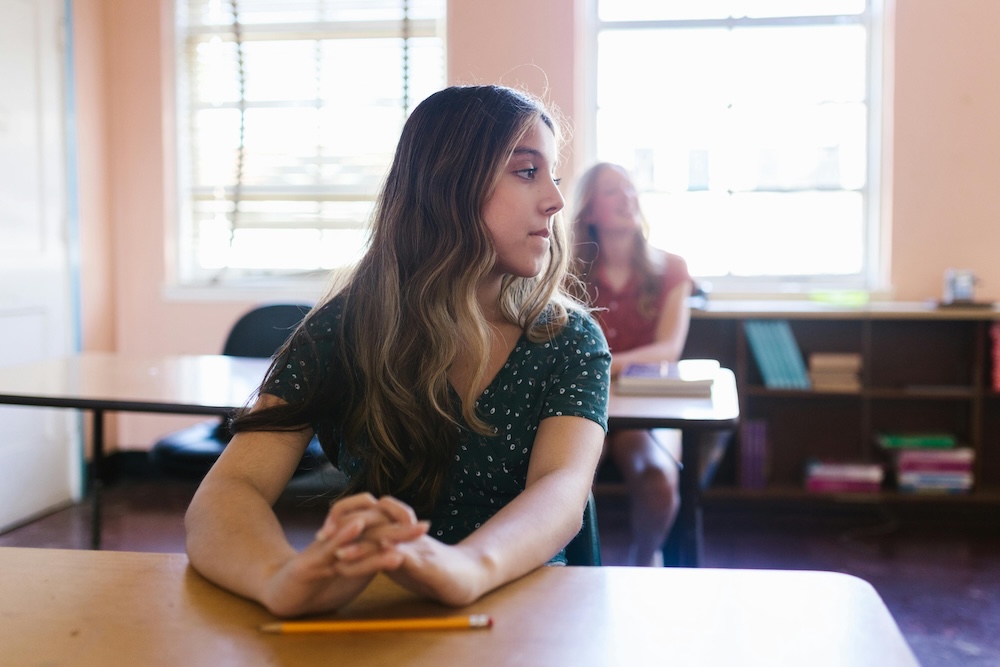
Creating a calm and focused classroom environment is essential for student success. Whether students are dealing with frustration, anxiety, or overstimulation, having structured calming activities for the classroom can help them regulate their emotions, refocus, and feel more at ease.
By incorporating mindfulness techniques, sensory strategies, and self-calming exercises, teachers can provide students with valuable tools to manage stress and stay engaged in learning. In this article, we’ll explore effective calming classroom ideas, relaxing activities for students, and structured mindfulness exercises that can easily be implemented in any classroom setting.
The Importance of Calming Strategies in the Classroom
Students experience a variety of emotions throughout the school day. Some may struggle with anxiety, others may feel anger or frustration, and many simply need moments to pause and reset. Providing calming strategies for teachers and students fosters an emotionally safe learning space while equipping children with lifelong self-regulation skills.
Benefits of Calming Activities for Kids
- Reduces Classroom Stress: Simple classroom stress relief activities help students feel more at ease, leading to better focus and engagement.
- Promotes Emotional Regulation: Teaching self-calming strategies for students helps them manage strong emotions and respond thoughtfully rather than react impulsively.
- Encourages Mindfulness and Focus: Implementing a structured lesson plan on mindfulness helps students practice staying present and aware of their emotions.
- Supports Sensory Needs: Many students benefit from calming sensory activities for the classroom, which help reduce overstimulation and improve concentration.
By incorporating intentional calming strategies for anxiety and anger, teachers can transform their classrooms into peaceful and supportive environments.
Mindfulness-Based Calming Activities for the Classroom
Mindfulness is a powerful tool for helping students slow down, center themselves, and build awareness of their thoughts and emotions. Below are calming activities for students that teachers can implement daily.
1. The Empty Balloon Exercise
One of the most effective calming strategies for anger and anxiety is mindful breathing. The Empty Balloon Exercise teaches students how to release tension and regulate their breathing to achieve a sense of calm.
How It Works:
- Ask students to imagine they are holding a balloon in their hands.
- Instruct them to take a deep breath in through their nose and slowly exhale through their mouth, as if they are filling the balloon with air.
- Repeat three to five times, encouraging students to focus on their breath and feel their body relax.
This simple yet powerful exercise helps students regain control of their emotions, making it a great calming activity for anger and anxiety.
2. Guided Mindfulness Meditation
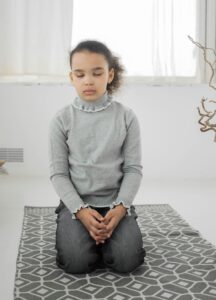 A structured lesson plan on mindfulness can include short guided meditation sessions to encourage self-awareness and emotional balance.
A structured lesson plan on mindfulness can include short guided meditation sessions to encourage self-awareness and emotional balance.
How to Implement:
- Start the morning with a two-minute mindful breathing session to set a calm tone for the day.
- Use a visualization exercise where students imagine a peaceful place and describe what they see, hear, and feel.
- Have students place their hands on their stomachs and focus on their breathing, noticing how their body moves with each inhale and exhale.
Regular practice of mindfulness strengthens students’ ability to manage stress and improves their ability to focus.
Calming Sensory Strategies for the Classroom
Many students benefit from sensory breaks in the classroom, which help them regulate their energy levels and refocus. Sensory-based calming activities for kids can be especially useful for students with sensory processing needs or those who experience anxiety.
Calming Sensory Activities for the Classroom
- Tactile Stress Balls: Squeezing a soft stress ball provides physical feedback that helps with emotional regulation.
- Weighted Lap Pads or Stuffed Animals: These provide a grounding sensation that can help students feel safe and secure.
- Calm-Down Jars: A jar filled with water and glitter can serve as a visual relaxation tool for students. Shaking the jar and watching the glitter settle can help them self-regulate.
Incorporating calming sensory strategies into daily routines ensures that students have access to tools that help them feel more at ease.
Movement-Based Calming Strategies for Students
Physical movement can also be an effective way to regulate emotions and promote relaxation. Encouraging students to engage in calming strategies helps maintain a balanced classroom atmosphere.
1. Stretching Breaks
- Seated Forward Fold: Have students sit with their legs extended and gently fold forward to stretch their backs and calm their nervous system.
- Butterfly Breaths: Sitting cross-legged, students gently flap their knees like butterfly wings while taking deep breaths.
- Star Pose: Students stand with their arms and legs stretched wide like a star, take a deep breath, and then bring their hands to their hearts.
A short sensory break in the classroom with stretching can significantly improve focus and relaxation.
2. Walk and Reflect
- Allow students to take quiet reflection walks around the classroom or hallway to reset their focus.
- Encourage them to walk slowly, notice their surroundings, and take deep breaths as they move.
- Pair this with reflective questions such as, “What are you feeling right now?” or “What’s something positive that happened today?”
These movement-based activities help students regulate their energy and encourages them to practice these self-calming strategies for students in a mindful way.
Using Tools of the Heart for Emotional Regulation
For a more structured approach to calming classroom ideas, Soul Shoppe’s Tools of the Heart Online Course provides teachers with step-by-step guidance for integrating mindfulness and emotional regulation techniques into the classroom.
This program includes:
✔ Interactive lessons on mindfulness and emotional intelligence
✔ Guided exercises for self-calming strategies
✔ Techniques for improving classroom communication and conflict resolution
By incorporating these strategies into daily teaching, educators can provide students with the skills they need to handle stress, frustration, and overwhelm effectively.
Creating a Calm and Supportive Classroom Environment
Establishing calming classroom ideas isn’t just about individual exercises—it’s about fostering an overall sense of peace and emotional well-being. Here are additional ways teachers can promote classroom stress-relief activities:
- Set the Tone with a Peaceful Classroom Design – Use soft lighting, neutral colors, and minimal distractions to create a calm atmosphere.
- Encourage Open Conversations About Emotions – Normalize discussions about feelings and self-care to build emotional intelligence.
- Implement Daily Mindfulness Practices – Incorporate a short breathing exercise, gratitude reflection, or movement break into each school day.
- Offer a Designated Calm-Down Space – Set up a quiet area where students can go to practice self-calming strategies for students when they need a break.
By prioritizing mindfulness and emotional regulation, educators can help students develop lifelong skills for managing stress and fostering well-being.
Bring More Calm to Your Classroom Today
Providing students with effective calming activities for the classroom is essential for creating a focused and emotionally balanced learning environment. By integrating mindfulness techniques, movement-based relaxation, and calming sensory strategies, educators can give students the tools they need to succeed.
Explore the Empty Balloon Exercise and Tools of the Heart curriculum today to bring more calm, mindfulness, and emotional resilience into your classroom!
You May Also Like:
Growth Mindset in the Classroom
Signs of Stress in Children
How To Help Students With Anxiety





 Let’s walk through student-centered strategies that give kids the tools to navigate tough moments themselves, with adult support when needed.
Let’s walk through student-centered strategies that give kids the tools to navigate tough moments themselves, with adult support when needed.
 Let’s walk through a few ways to open up these conversations with care and connection.
Let’s walk through a few ways to open up these conversations with care and connection.



 SEL (Social-Emotional Learning) plays a critical role in
SEL (Social-Emotional Learning) plays a critical role in 
 A structured
A structured